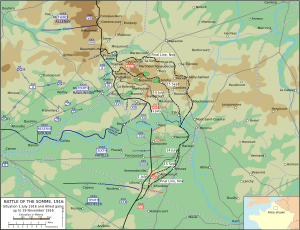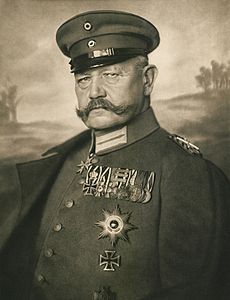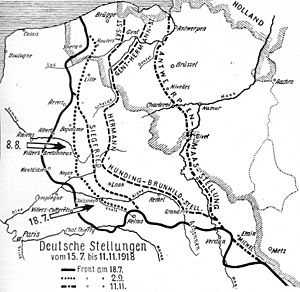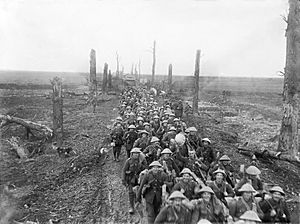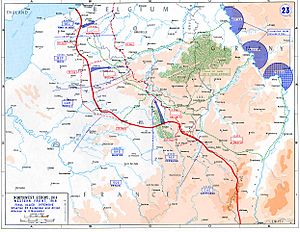Hindenburg Line facts for kids
Quick facts for kids The Hindenburg Line |
|
|---|---|
| Siegfriedstellung | |
| Northeastern France | |
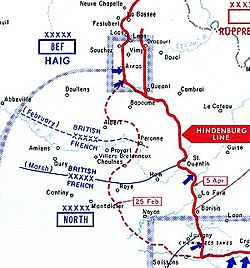
Map showing the German withdrawal to Hindenburg Line.
|
|
| Coordinates | 49°30′N 02°50′E / 49.500°N 2.833°E |
| Type | Fortification |
| Site history | |
| Built | 1917 |
| Built by | Imperial German Army
|
| In use | 1917–1918 |
| Materials | Concrete, steel, barbed wire |
| Battles/wars | World War I |
The Hindenburg Line (also known as the Siegfried Position by the Germans) was a very strong system of forts and trenches. The German Empire built it in northeastern France during the winter of 1916-1917. It was designed to defend against attacks from the French and British armies during World War I. After the war, France built a similar but even bigger defense line called the Maginot Line to protect against Germany.
Contents
Why the Hindenburg Line Was Built
Germany's Tough Times in 1916
In 1916, the German army was facing huge challenges on the Western Front (World War I). They had fought long and costly battles, like the Battle of the Somme. Their soldiers were tired, and they were running low on supplies and equipment. The constant fighting meant they needed a lot of new soldiers and guns.
Germany's top military leaders, Paul von Hindenburg and Erich Ludendorff, took over in August 1916. They realized the army couldn't keep fighting in the same way. They needed a new plan to save soldiers and resources.
A Shorter, Stronger Defense Line
Hindenburg and Ludendorff decided to build a shorter, stronger defensive line. This new line would allow them to pull back their troops from some areas. This would free up soldiers to be used as reserves or sent to other battlefronts. The idea was to make their defense more efficient and save manpower.
Work on this new line, called the Siegfriedstellung (Siegfried Position), began in September 1916. It was a massive project, showing how desperate Germany was to improve its defenses.
Building the Hindenburg Line
A Strong New Fortification System
The Hindenburg Line was about 90 miles (145 km) long. It was designed to be incredibly strong. It had two main trench lines, about 200 yards (180 m) apart. In front of these trenches were huge fields of barbed wire, up to 100 yards (90 m) deep. This wire was set up in zig-zags so machine guns could easily sweep the area.
The Germans built many concrete bunkers and observation posts. These were often hidden on the back slopes of hills. This made it harder for enemy artillery to hit them. Thousands of German and Belgian workers, along with about 50,000 prisoners of war, helped build this huge defense. They used a lot of concrete, steel, and barbed wire.
New Defensive Tactics
Along with the new line, the German army also changed its fighting tactics. Instead of holding every front-line trench at all costs, they planned a more flexible defense. Small groups of soldiers would hold the front, and if the enemy broke through, reserve troops would quickly counter-attack. This was meant to save lives and make their defense more effective.
The German Retreat: Operation Alberich
A Planned Withdrawal to the New Line
The German army began its planned withdrawal to the Hindenburg Line in February 1917. This operation was codenamed Alberich Bewegung (Alberich Manoeuvre). It was a carefully planned retreat over several weeks.

As they pulled back, the Germans used a "scorched-earth" tactic. This meant they destroyed everything that could be useful to the Allied armies. They cut down trees, blew up bridges, ruined roads, and polluted wells. They also planted many booby-traps and delayed-action explosives in abandoned buildings and roads. This was done to slow down the Allied advance and make it harder for them to supply their troops.
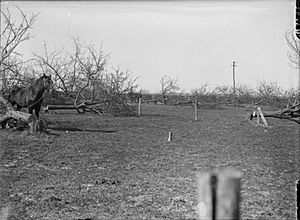
Allied Pursuit and Challenges
The British and French armies followed the retreating Germans. They found the destroyed land very difficult to move through. Roads were ruined, and the spring thaw turned many areas into mud. This made it hard to bring up supplies, guns, and fresh troops.
Allied patrols and advanced groups tried to keep contact with the Germans. They often met strong German rearguards who fought fiercely before retreating further. The Allies had to be careful because the Germans might try a surprise counter-attack.
The German withdrawal was successful in shortening their front line by about 25 miles (40 km). This allowed them to save soldiers and prepare for the expected Allied spring attacks.
Battles Along the Hindenburg Line
The Nivelle Offensive and Arras (April 1917)
The Hindenburg Line became a key battleground. In April 1917, the British launched the Battle of Arras to the north of the Hindenburg Line. This was part of a larger French plan called the Nivelle Offensive. The British had some early successes, but the Germans used their new defensive tactics and reinforcements to stop the advance.
First Battle of Bullecourt (April 1917)
As part of the Arras offensive, the British tried to attack the Hindenburg Line directly at Bullecourt. This attack on April 11, 1917, involved tanks, but it did not go well. The tanks were delayed, and many were knocked out. The Australian infantry suffered heavy losses trying to break through the strong German defenses and barbed wire.
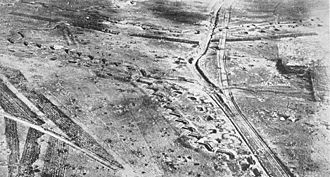
Second Battle of Bullecourt (May 1917)
Another attack on Bullecourt happened in May 1917. After heavy fighting, British and Australian troops managed to capture parts of the Hindenburg Line. However, the battles were very costly for both sides, with thousands of casualties.
Battle of Cambrai (November 1917)
In November 1917, the British launched a surprise attack at Cambrai, using a large number of tanks. They broke through the first parts of the Hindenburg Line. However, the German defenses in the rear, especially the Siegfried II Stellung, held strong. The Germans quickly counter-attacked, using new tactics and regaining some of the lost ground.
Breaking the Hindenburg Line (1918)
The Final Allied Push
By late 1918, the Allies had gained strength and improved their tactics. They launched a series of massive attacks known as the Hundred Days Offensive. On September 29, 1918, British, American, and French forces attacked the Hindenburg Line.
The Allies used overwhelming power, combining infantry, tanks, and artillery. They finally broke through the Hindenburg Line, taking many prisoners and guns. The German soldiers were exhausted and their morale was very low. This major breakthrough was a key moment that led to the end of World War I. On October 8, 1918, the German armies were ordered to retreat from the rest of the Hindenburg Line.
Images for kids
See also
 In Spanish: Línea Hindenburg para niños
In Spanish: Línea Hindenburg para niños


